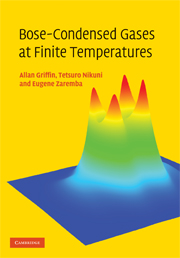Book contents
- Frontmatter
- Contents
- Preface
- 1 Overview and introduction
- 2 Condensate dynamics at T = 0
- 3 Coupled equations for the condensate and thermal cloud
- 4 Green's functions and self-energy approximations
- 5 The Beliaev and the time-dependent HFB approximations
- 6 Kadanoff–Baym derivation of the ZNG equations
- 7 Kinetic equation for Bogoliubov thermal excitations
- 8 Static thermal cloud approximation
- 9 Vortices and vortex lattices at finite temperatures
- 10 Dynamics at finite temperatures using the moment method
- 11 Numerical simulation of the ZNG equations
- 12 Simulation of collective modes at finite temperature
- 13 Landau damping in trapped Bose-condensed gases
- 14 Landau's theory of superfluidity
- 15 Two-fluid hydrodynamics in a dilute Bose gas
- 16 Variational formulation of the Landau two-fluid equations
- 17 The Landau–Khalatnikov two-fluid equations
- 18 Transport coefficients and relaxation times
- 19 General theory of damping of hydrodynamic modes
- Appendix A Monte Carlo calculation of collision rates
- Appendix B Evaluation of transport coefficients: technical details
- Appendix C Frequency-dependent transport coefficients
- Appendix D Derivation of hydrodynamic damping formula
- References
- Index
12 - Simulation of collective modes at finite temperature
Published online by Cambridge University Press: 06 October 2009
- Frontmatter
- Contents
- Preface
- 1 Overview and introduction
- 2 Condensate dynamics at T = 0
- 3 Coupled equations for the condensate and thermal cloud
- 4 Green's functions and self-energy approximations
- 5 The Beliaev and the time-dependent HFB approximations
- 6 Kadanoff–Baym derivation of the ZNG equations
- 7 Kinetic equation for Bogoliubov thermal excitations
- 8 Static thermal cloud approximation
- 9 Vortices and vortex lattices at finite temperatures
- 10 Dynamics at finite temperatures using the moment method
- 11 Numerical simulation of the ZNG equations
- 12 Simulation of collective modes at finite temperature
- 13 Landau damping in trapped Bose-condensed gases
- 14 Landau's theory of superfluidity
- 15 Two-fluid hydrodynamics in a dilute Bose gas
- 16 Variational formulation of the Landau two-fluid equations
- 17 The Landau–Khalatnikov two-fluid equations
- 18 Transport coefficients and relaxation times
- 19 General theory of damping of hydrodynamic modes
- Appendix A Monte Carlo calculation of collision rates
- Appendix B Evaluation of transport coefficients: technical details
- Appendix C Frequency-dependent transport coefficients
- Appendix D Derivation of hydrodynamic damping formula
- References
- Index
Summary
In this chapter we present several dynamical simulations that make use of the numerical methods discussed in the previous chapter. Some of these are model simulations that are not directly linked to experiment but are designed to investigate some aspect of the dynamical behaviour. Others are performed with the express purpose of explaining specific experimental data. Both kinds of simulation serve to illustrate the range of nonequilibrium phenomena that can be studied in ultracold Bose gases using the ZNG equations.
A dynamical simulation is typically initiated in one of two ways. Either an appropriate nonequilibrium initial state is imposed on the system, or the system, initially in equilibrium, is dynamically excited by the application of an external perturbation. The latter parallels the procedure used experimentally to study small-amplitude collective excitations and usually amounts to some parametric modulation of the trapping potential. However, this approach may not always be feasible if the excitation phase requires a prohibitively long simulation time. In this case, the best one can do is to specify some initial nonequilibrium state that represents the experimental situation as closely as possible. This is not an issue in model simulations, where we are at liberty to specify the initial state in whatever way serves our purpose.
In Sections 12.1–12.3 we present three examples of model simulations. All essentially check some aspect of the numerical procedures. By studying the equilibration of an initial nonequilibrium state in Section 12.1, we confirm that the total number of atoms is conserved to a very good approximation during the course of the evolution. This is a nontrivial result since, as explained at the end of subsection 11.3.2, the numbers of condensate and thermal atoms change in quite different ways.
- Type
- Chapter
- Information
- Bose-Condensed Gases at Finite Temperatures , pp. 256 - 291Publisher: Cambridge University PressPrint publication year: 2009



